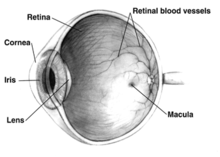Glaucoma
|
|
Glaucoma is a group of diseases of the optic nerve involving loss of retinal ganglion cells in a characteristic pattern of optic neuropathy. Raised intraocular pressure is a significant risk factor for developing glaucoma. There is no set threshold for intraocular pressure that causes glaucoma — while one person may develop nerve damage at a relatively low pressure, another person may have high eye pressures for years and yet never develop damage. Untreated glaucoma leads to permanent damage of the optic disc of the retina and resultant visual field loss, which can progress to blindness.
| Contents |
Types
The most common type, primary open angle glaucoma (POAG), frequently has no symptoms and has been nicknamed "the thief of sight". One factor may be a relative obstruction on the outflow of aqueous humour from the eye. Aqueous humour is produced by the ciliary body of the eye, and then flows through the pupil and into the anterior chamber. The trabecular meshwork then drains the humour to Schlemm's canal, and ultimately to the venous system. All eyes have some intraocular pressure, which is caused by some resistance to the flow of aqueous through the trabeculum and Schlemm's canal. If the intraocular pressure (IOP) is too high, (>21.5 mm Hg), the pressure exerted on the walls of the eye result in compression of the ocular structures. However, other factors such as disturbances of blood flow in the optic nerve head may interact with IOP to affect the optic nerve. In one third of cases of POAG there is statistically normal IOP. This is called normal tension glaucoma (NTG). Because optic nerve examination and perimetry testing are not always done in addition to IOP measurement in those at risk, NTG is underdiagnosed and the condition presents late.
Another type, acute angle-closure glaucoma, is characterized by an acute rise in the intraocular pressure. This occurs in susceptible eyes when the pupil dilates and blocks the flow of fluid through it, leading to the peripheral iris blocking the trabecular meshwork. Acute angle-closure glaucoma can cause pain and reduced visual acuity (blurred vision), and may lead to irreversible visual loss within a short time. This is an ocular emergency requiring immediate treatment. Many people with glaucoma experience halos around bright lights as well as the loss of sight characterized by the disease.
Primary congenital glaucoma or buphthalmos is a rare genetic disease affecting infants. Newborns present with enlarged globes and clouded corneas. It is thought that reduced trabecular permeability is the cause of increased intraocular pressure. Surgery is the treatment.
Secondary glaucoma occurs as a complication of various medical conditions such as eye surgery, advanced cataracts, eye injuries, some eye tumors, uveitis, diabetes or use of corticosteroid drugs.
Symptoms
While glaucoma may or may not have distinct symptoms, an almost inevitable complication of glaucoma is vision loss. Visual loss from glaucoma first affects peripheral vision. Early vision loss is subtle, and is not noticed by the patient. Moderate to severe vision loss may be noticed by the patient by checking his peripheral vision thoroughly. This can be done by closing one eye and examining all four corners of the visual field for clarity and sharpness, then repeating with the other eye closed. All too often, the patient does not notice the loss of vision until he experiences "tunnel vision". If the disease is not treated, the visual field will become more and more narrow, obscuring central vision, and finally progressing to blindness in the affected eye(s).
Waiting for symptoms of visual loss to occur is not optimal care. Visual loss related to glaucoma is irreversible, but can be prevented or slowed by treatment. An optometrist or ophthalmologist should be consulted by people at risk for glaucoma.
Risk factors and diagnosis
Human_eyesight_two_children_and_ball_with_glaucoma.jpg
People with a family history of glaucoma have about a six percent chance of developing glaucoma. Diabetics and Blacks are more prone to open angle glaucoma, and Asians are more prone to develop angle-closure glaucoma. Ideally, everyone over the age of thirty-five should be checked for glaucoma, with the frequency of the checkups increasing with age. Half the people who have glaucoma do not know that they have it.
A number of studies suggest that there is a correlative, not necessarily causal, relationship between glaucoma and systemic hypertension (i.e. high blood pressure).
Screening for glaucoma is usually performed as part of a standard eye examination performed by an ophthalmologist or optometrist. Testing for glaucoma should include measurement of the intraocular pressure, as well as examination of the optic nerve to look for any damage to it. If there is any suspicion of damage to the optic nerve, a formal visual field test should be performed. Scanning laser ophthalmoscopy may also be performed.
Treatment
Although intraocular pressure is only one of the causes of glaucoma, at the current time lowering it is the mainstay of glaucoma treatment.
Drugs
Intraocular pressure can be lowered with medication,usually eye drops. There are several different classes of medications to treat glaucoma with several different medications in each class. Topical beta-adrenergic receptor antagonists such as timolol decrease aqueous humor production by the ciliary body. Alpha2-adrenergic agonists such as brimonidine (Alphagan) work by decreasing aqueous production. Less-selective sympathomimetics like epinephrine and dipivefin (Propine) increase outflow of aqueous humor through trabecular meshwork and possibly through uveoscleral outflow pathway, probably by a beta2-agonist action. Miotic agents (parasympathomimetics) like pilocarpine work by contraction of the ciliary muscle, tightening the trabecular meshwork and allowing increased outflow of aqueous through traditional pathways. Carbonic anhydrase inhibitors like Dorzolamide (Trusopt), Brinzolamide (Azopt), Acetazolamide (Diamox) lower secretion of aqueous humor by inhibiting carbonic anhydrase in the ciliary body. Prostaglandin analogs like latanoprost (Xalatan) increase uveoscleral outflow of aqueous.
Marijuana has been shown to lower the intraocular pressure in some eyes in a few studies but this is generally not used clinically.
The possible neuroprotective effects of various topical and systemic medications are also being investigated.
Surgery
(See Eye surgery)
Both laser and conventional surgeries are performed to treat glaucoma. Laser trabeculoplasty may be used to treat open angle glaucoma. An argon or Nd:YAG laser spot is aimed at the trabecular meshwork to stimulate opening of the mesh to allow more outflow of aqueous fluid. Laser peripheral iridectomy may be used in patients susceptible to angle closure glaucoma. In it, the laser is aimed at the iris to make an opening in it. This allows a new channel for fluid to flow when the usual channel through the dilated pupil is blocked.
The most common conventional surgery performed for glaucoma is the trabeculectomy. Here, a partial thickness flap is made in the scleral wall of the eye, and a window opening made under the flap to remove a portion of the trabecular meshwork. The scleral flap is then sutured loosely back in place. This allows fluid to flow out of the eye through this opening, resulting in lowered intraocular pressure.
There are also several different small tubes that are inserted into the anterior chamber of the eye and out underneath the conjunctiva to allow flow of fluid out of the eye.
Major Studies
- Advanced Glaucoma Intervention Study (AGIS) (http://www.nei.nih.gov/neitrials/static/study49.asp) - large American National Eye Institute (NEI) sponsored study designed "to assess the long-range outcomes of sequences of interventions involving trabeculectomy and argon laser trabeculoplasty in eyes that have failed initial medical treatment for glaucoma." It recommends different treatments based on race.
- Early Manifest Glaucoma Trial (EMGT) (http://www.nei.nih.gov/earlyglaucoma/index.asp) -Another NEI study found that immediately treating people who have early stage glaucoma can delay progression of the disease.
- Ocular Hypertension Treatment Study (OHTS) (http://www.nei.nih.gov/neitrials/viewStudyWeb.aspx?id=24) -NEI study findings: "...Topical ocular hypotensive medication was effective in delaying or preventing onset of Primary Open Angle Glaucoma (POAG) in individuals with elevated Intraocular Pressure (IOP). Although this does not imply that all patients with borderline or elevated IOP should receive medication, clinicians should consider initiating treatment for individuals with ocular hypertension who are at moderate or high risk for developing POAG."
- Blue Mountains Eye Study (http://www.cvr.org.au/pages/bmes/bmes.htm) "The Blue Mountains Eye Study was the first large population-based assessment of visual impairment and common eye diseases of a representative older Australian community sample." Risk factors for glaucoma and other eye disease were determined.
References
- What is glaucoma? Centre for Vision Research (CVR), Sydney (http://www.cvr.org.au/pages/common-eye-diseases/glaucoma.htm)
- Glaucoma risk factors. CVR (http://www.cvr.org.au/pages/common-eye-diseases/glaucoma-riskfactors.htm)
- OMIM. Genetics of adult onset POAG (http://www.ncbi.nlm.nih.gov/entrez/dispomim.cgi?id=137760)
- OMIM. Susceptibility to normal tension glaucoma. (http://www.ncbi.nlm.nih.gov/entrez/dispomim.cgi?id=606657)
- OMIM Primary Infantile Glaucoma (http://www.ncbi.nlm.nih.gov/entrez/dispomim.cgi?id=231300)
- U of Iowa patient tutorial (http://webeye.ophth.uiowa.edu/eyeforum/glaucoma.htm)
- eMedicine article on POAG (http://www.emedicine.com/oph/topic139.htm)he:גלאוקומה
de:Glaukom es:Glaucoma eo:Glaŭkomo fr:Glaucome it:Glaucoma (medicina) ms:Glaukoma nl:Glaucoom ja:緑内障 pl:Jaskra zh:青光眼


